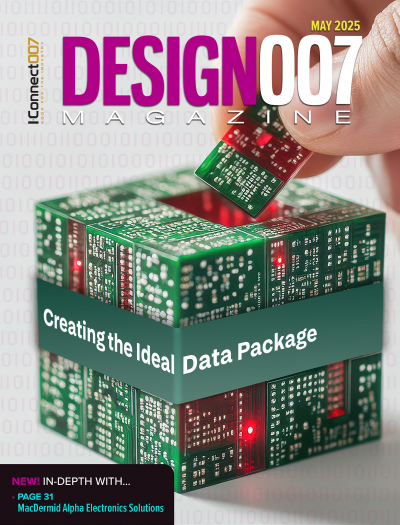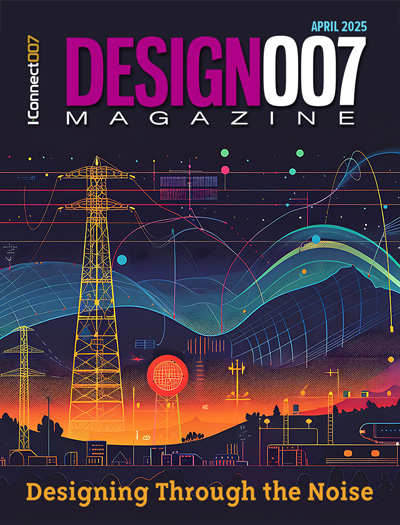-

- News
- Books
Featured Books
- design007 Magazine
Latest Issues
Current Issue
All About That Route
Most designers favor manual routing, but today's interactive autorouters may be changing designers' minds by allowing users more direct control. In this issue, our expert contributors discuss a variety of manual and autorouting strategies.

Creating the Ideal Data Package
Why is it so difficult to create the ideal data package? Many of these simple errors can be alleviated by paying attention to detail—and knowing what issues to look out for. So, this month, our experts weigh in on the best practices for creating the ideal design data package for your design.

Designing Through the Noise
Our experts discuss the constantly evolving world of RF design, including the many tradeoffs, material considerations, and design tips and techniques that designers and design engineers need to know to succeed in this high-frequency realm.
- Articles
- Columns
- Links
- Media kit
||| MENU - design007 Magazine
A Design Economics Primer
May 21, 2020 | I-Connect007 Editorial TeamEstimated reading time: 1 minute
When you start a new design, do you begin tracking costs right away, or do you wait until you have a functioning product before you start looking at the dollars and cents? Chris Young begins cost-aware design before the design cycle has even begun. Andy Shaughnessy and Nolan Johnson recently interviewed Chris, an engineer with The Goebel Company and founder of Young Engineering Services, and asked him to explain his approach to design economics.
Andy Shaughnessy: Tell us about your position and responsibilities, and we’ll go from there.
Chris Young: At The Goebel Company, I’m the chief hardware engineer. My primary responsibilities are product architecture, design, and development, which starts from a customer need and progresses into delivery and sustainability.
Shaughnessy: You have a pretty wide view of things.
Young: I’ve been lucky to be exposed to quite a bit of stuff. I’ve worked on product development from the cradle to the grave in the avionics industry, semiconductor and semiconductor test, and developing test systems for space and medical devices, ranging from airborne surveillance systems to electromechanical medical devices. I’ve had the pleasure of working with many different people in various industries.
Shaughnessy: We have been talking about design for profitability for a couple of years, and we started looking into the whole issue of design economics. In your position, how important is the cost of what you’re doing? Young: Along with the chief technologist, we are primarily responsible for the profitability of the company. The products that I design are directly related to revenue and profit.
Shaughnessy: You’re looking at the cost from the very beginning of the design cycle?
Young: You must. In my career, I have developed a systems view of what’s happening, which has shaped how I approach the issue of costs and profitability. It also depends on the environment that you’re in. I always ask myself basic questions, such as, “What are we trying to do? When do we need to do it? How are we going to do it? Which market are we addressing? What do we think our budget is?”
To read this entire article, which appeared in the April 2020 issue of Design007 Magazine, click here.
Suggested Items
DownStream Acquisition Fits Siemens’ ‘Left-Shift’ Model
06/26/2025 | Andy Shaughnessy, I-Connect007I recently spoke to DownStream Technologies founder Joe Clark about the company’s acquisition by Siemens. We were later joined by A.J. Incorvaia, Siemens’ senior VP of electronic board systems. Joe discussed how he, Rick Almeida, and Ken Tepper launched the company in the months after 9/11 and how the acquisition came about. A.J. provides some background on the acquisition and explains why the companies’ tools are complementary.
Elementary Mr. Watson: Retro Routers vs. Modern Boards—The Silent Struggle on Your Screen
06/26/2025 | John Watson -- Column: Elementary, Mr. WatsonThere's a story about a young woman preparing a holiday ham. Before putting it in the pan, she cuts off the ends. When asked why, she shrugs and says, "That's how my mom always did it." She asks her mother, who gives the same answer. Eventually, the question reaches Grandma, who laughs and says, "Oh, I only cut the ends off because my pan was too small." This story is a powerful analogy for how many PCB designers approach routing today.
Connect the Dots: The Future of PCB Design and Manufacturing
07/02/2025 | Matt Stevenson -- Column: Connect the DotsFor some time, I have been discussing the increasing complexity of PCBs and how designers can address the constantly evolving design requirements associated with them. My book, "The Printed Circuit Designer’s Guide to… Designing for Reality," details best practices for creating manufacturable boards in a modern production environment.
Siemens Turbocharges Semiconductor and PCB Design Portfolio with Generative and Agentic AI
06/24/2025 | SiemensAt the 2025 Design Automation Conference, Siemens Digital Industries Software today unveiled its AI-enhanced toolset for the EDA design flow.
Cadence AI Autorouter May Transform the Landscape
06/19/2025 | Andy Shaughnessy, Design007 MagazinePatrick Davis, product management director with Cadence Design Systems, discusses advancements in autorouting technology, including AI. He emphasizes a holistic approach that enhances placement and power distribution before routing. He points out that younger engineers seem more likely to embrace autorouting, while the veteran designers are still wary of giving up too much control. Will AI help autorouters finally gain industry-wide acceptance?


